Mar 26, 2015
Getting Stronger
More than 100 students enrolled in a program launched this fall in which they earn an Intercultural Competency Certificate from the Office of Intercultural…
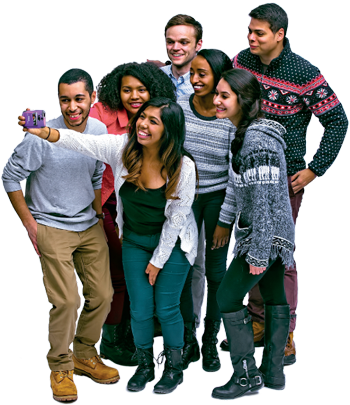
Erika Hernandez ’17 (holding camera), Robert Sanchez ’16 (L-R), Valerie Melson ’17, Aaron Little ’16, Aynalem Regassa ’18, Fatima Akbar ’18, Eddie Andujar ’15
By Margie Peterson | Photo Illustration by Dale Mack
Twenty-five percent of the members of the incoming class in fall 2013 were students of color, an historic milestone for Lafayette. That success continued the following year with another two percent increase. This achievement is just one of a variety of things that the admissions team has accomplished in meeting the goal of enrolling a more diverse student body.
In an interconnected, globalized world, students benefit from learning in educational and social contexts that include participants from all backgrounds.
“The more diverse we are, the stronger we are,” says Greg MacDonald, vice president for enrollment management.
Students come from more states than ever, and the number of international students, who currently represent 44 countries, is at an all-time high. In addition, the student body reflects much wider-ranging differences in religious or spiritual identity, socioeconomic status, sexual orientation, and gender identity.
The increased diversity of the student body is an achievement worth celebrating. The numbers are critically important because they increase the likelihood that students will encounter different perspectives and worldviews in their courses, co-curricular activities, and social interactions. The College aims to create a wide range of structured opportunities for student engagement across social identities and cultural divides.
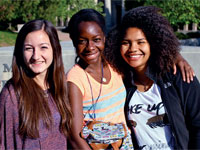
Gabrielle Minassian ’17 (L-R), Chanel Mowatt ’17, and Valerie Melson ’17 attended the From Me to We social justice retreat.
Students from all backgrounds need to understand that their time at Lafayette likely offers the best opportunity they will ever have to step outside of personal comfort zones and seek to develop cultural competencies, says John McKnight, dean of intercultural development. One example is the recent gathering of the campus community to talk about the police-related deaths of Michael Brown in Ferguson, Mo., and Eric Garner in Staten Island, N.Y., and the controversial grand jury verdicts.
“There were a lot of new faces, a lot of first-year students who weren’t afraid to share their opinions, even not afraid to say, ‘I don’t know a lot about this topic but I came here because so many people seemed to care about it, and I wanted to know more,’” says Valerie Melson ’17, a member of Association of Black Collegians and one of the organizers.
More than 200 students, faculty, and staff attended the meeting, which occurred on the eve of finals. They broke into smaller groups for discussion facilitated by students, then re-gathered to share their feelings and experiences via open mic.
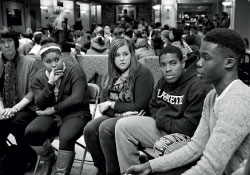
A community gathering was held in December to talk about the police-related deaths of minorities and the controversial grand jury verdicts.
Students say the push for more diversity on campus has borne fruit in a variety of ways including classroom discussions, late-night talks in dorms and on retreats, and at Hillel House brunches where students of all faiths come for the bagels and stay for the open atmosphere. Students understand that such interactions often result in the formation of allegiances across social divides.
In 2014, the Muslim holy day of Eid al-Adha and the day to break the fast of the Jewish observance Yom Kippur both fell on Oct. 4, so Muslim and Jewish students celebrated with a shared dinner. About 250 people, including students of other faiths, attended.
Alex Hendrickson, chaplain and director of religious and spiritual life, says she is impressed with how students from various faiths not only cooperate but advocate for each other.
“When we changed dining service providers in 2013 our evangelical Christian group wrote a letter to the administration saying, ‘it is important that there are kosher and halal options’,” says Hendrickson. “And, our Jewish students were major proponents for a Muslim prayer room.”

These interfaith connections are signs that the increase in diversity has led to greater dialogue and understanding among students. The College has a Catholic campus minister who advises the Newman Association, a Jewish chaplain who directs the Hillel program, a Muslim adviser, and a Buddhist adviser, in addition to advisers who work with other Christian organizations.
Hendrickson also advises Kaleidoscope, an intercultural development program in which student coordinators of peer education (SCOPES) promote dialogue and lead sessions in which participants explore issues of multiculturalism, equity, and social justice. This program is one of many that have helped transform the campus culture into being ever more welcoming and inclusive to students from many backgrounds and cultures.
Melson, a Posse Scholar and neuroscience major, is a SCOPE. Her friends Robert Sanchez ’16, an international affairs and philosophy major, and Eddie Andujar ’15, international affairs and Latin American and Caribbean Studies, are as well.
Another event that has strengthened the diversity of the campus culture and helped raise the appeal of the College to students from more widely ranging backgrounds is the Our Beloved Community symposium, says McKnight. Prospective students who have expressed an interest in Lafayette are invited to attend and participate in discussions on issues related to diversity and social justice with current students, faculty, and staff.
“One of the reasons I chose Lafayette was because of this program,” says Erika Hernandez ’17, an admissions ambassador. “I was able to grasp the sense of community here. Besides everyone’s hospitality, I appreciated the conversations. We discussed social justice and what we could bring to campus and or might do in our own towns.”
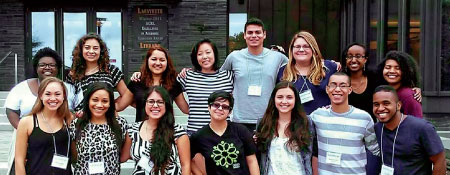
Student coordinators of peer education (SCOPES) who are involved in the Kaleidoscope intercultural development program lead workshops on multiculturalism and social justice.
Many highly selective liberal arts colleges are making great strides in recruiting and supporting students from varying socioeconomic backgrounds. This form of diversity is often less visible, says McKnight, but incredibly important in terms of the way students will experience college. “The challenge is to create equitable access and to make opportunities affordable so that all students can take fullest advantage of this outstanding Lafayette education.”
Andujar, a Posse scholar, has maximized every opportunity extended. Coming from a low-income household, he says he initially experienced some culture shock in getting to know students from affluent families. Although Puerto Rican, he grew up in New York and never learned Spanish because his mother, who was born in the city, only spoke English. “I couldn’t converse with my grandparents in their native tongue. I felt disenfranchised from my family, community, and self.”
But living in Grossman House, a residence for students interested in global studies, and studying abroad in more than 10 countries, he has met students from around the world with vastly different experiences and perspectives. “I discovered my community despite the fact that we are all from different places.” He attributes his participation in
an Alternative School Break trip to El Salvador as one of the contributing factors to his love of the Spanish language.
Participation in volunteer activities such as ASB brings together students from varying backgrounds and majors.
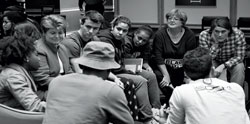
“Research suggests that people who engage with diversity are more complex thinkers.”
— John McKnight
In fact, a new living group in Conway House that is focused on community engagement epitomizes the blending of diverse cultures. Thirty first-year students live together based on their shared commitment to community service and leadership in programs sponsored by the Landis Community Outreach Center and the Center for Community Engagement.
Participants come from Turkey, Egypt, Singapore, China, Pakistan, India, Texas, Rhode Island, Hawaii, New Jersey, and Maryland. They learn about active citizenship, leadership development through social change, and connect with upper-class leaders through ASB, pre-orientation service, living-learning communities, and more.
“Before coming here I had a very naïve perspective of American culture,” says Fatima Akbar ’18, of Kabul, Afghanistan. “All I knew was the news and the Army going through my street. Meeting all these people and learning their stories has taught me to look at people as people and not put them in boxes or categories based on their nationalities. It definitely plays a role in who we are, but it’s not all of who we are.”

Malahat Mazaher ’16, also from Afghanistan, notes that her country is 99 percent Muslim. She says she would never have met so many people of different religions and backgrounds if she had attended a university there. She was not only drawn to the challenge of coming to a culture different from her own, but also the style of learning.
“Back home we’re taught differently; it’s mostly memorization,” she says. “There is no critical thinking and no speaking up in class and questioning the professor. It has been really nice to learn to do that.”
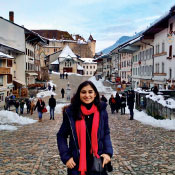
Malahat Mazaher ’16, an admissions ambassador, spent fall semester studying abroad in Switzerland.
An economics and international affairs major and past president of the Muslim Student Association, she helped organize a fall event on Islamophobia that attracted more than 200 people.
Mazaher and other students have helped Sanchez learn more about Islamic culture. As interfaith chair of the Newman Association, it’s his role to promote dialogue among students of different faith traditions. He has also helped shape his classmates’ education. “I know people for whom I was the first person of color they became friends with,” he says.
“At first I expected Lafayette to be more like white schools, but I have seen so many diverse groups and have met people from many different backgrounds,” says Aynalem Regassa ’18, a Conway House resident, who emigrated to the United States from Ethiopia two years ago. “We all have the same opportunities; there is no division. I have friends who are white, Asian, and African American.”
The lack of exposure to people from different backgrounds or of different ethnicity is familiar to Aaron Little ’16, Student Government president. He says there were no Muslims at his Catholic high school in Sparta Township, N.J., and only four or five African Americans. Now he has friends of different races and religions and has learned a lot interacting with members of diversity organizations and attending events such as the Eid/Yom Kipper celebration.
“It has been so interesting to see their passion for issues I hadn’t been introduced to in high school,” says Little. An openly gay man, he now finds that he is educating classmates about issues surrounding sexual orientation.
In 2012, the Office of Intercultural Development hired Gene Kelly as Lafayette’s first director of gender and sexuality programs. Among many other education and outreach initiatives supporting the College’s LGBTQ and ally community, Kelly introduced the national Safe Zone training program to campus. About 350 community members have participated.
To learn more about the LGBT community, Sanchez joined Quest, the student organization for the exploration of gender and sexuality issues. He also became interested in women’s rights and is now vice president of the Association of Lafayette Feminists.

During fall, Barker Carlock ’17 (above) attended the faculty-led semester-abroad in Madrid. Back on campus, he meets with members of the Aviation Club (left).
Enhancing the diversity of the student body has also enriched exchange in the classroom.
Melson, a neuroscience major and Posse scholar, says it was eye-opening to hear a Rwandan student talk about that nation’s 1994 genocide and the reconciliation process that followed.
“In her country, she said that you’re not allowed to sweep issues under the rug. You have to be able to look at it and try to learn from it and attack it head on. She also said that practice has allowed her people to heal so much in such a short time.”
Because Melson’s mother works for the U.S. government, Melson was able to contribute personal insights in a class discussing the federal government shutdown in October 2013.
“Some people in the classroom thought it was a joke,” she says. “But I know for a fact that it was not a laughing matter.” Students who recognize these kinds of limitations in their perspectives can take steps to improve their intercultural competency in a program that began this year (see “Getting Stronger” ).
After growing up in a predominantly white, wealthy suburb of Dallas, Barker Carlock ’17 took a year off after high school and used his training as an EMT to volunteer at a medical center in Senegal in an all-black Muslim neighborhood. It was a life-changing experience, he says—and he wanted a college with diversity.
44%
of the class of 2018 received financial aid
“Going from being a majority to a minority really changed my perspective on race and marginalized groups. I had never experienced being judged by the color of my skin before. Being in a culture where you can’t do anything that is familiar—language, daily habits, and family—tears down who you are. I was able to recreate my own identity away from many preconceived ideas of what it means to be an 18-year-old-something male. That was the most important part.”
Carlock lives in McKelvy House, a residence with students from different majors and backgrounds who choose to focus on intellectual discourse, personal growth, and community engagement. “I’ve developed a great group of friends who have similar interests but different perspectives,” he says. “The understanding I’ve gained on the issue of race is by talking to my friends and peers—black, Hispanic, Asian—and hearing their perspectives.”
A chemical engineering major, he is currently participating in the semester-abroad in Spain for engineering students. He also created and is president of the new Aviation Club. “We are using flight as a tool to further broaden the perspective of the Lafayette student,” Carlock, a pilot himself, told The Lafayette (Nov. 14, 2014). “Flying gives people an entirely different perspective on life.”
So, other than learning how to get along with a wide variety of people, why does diversity matter?
“Psychological research suggests that people who can experience diversity and engage with it are actually more complex thinkers,” says McKnight. “And it makes sense from a brain-science prospective. If you’re able to challenge what you’ve always held to be true or to hold two competing ideas in your brain…it makes your brain stronger.”



More than 100 students enrolled in a program launched this fall in which they earn an Intercultural Competency Certificate from the Office of Intercultural…
Students have many opportunities for cross-cultural interaction. Here’s a partial list. For more, go to intercultural.lafayette.edu. Asian Cultural Association…
Lafayette College is committed to creating a diverse community: one that is inclusive and responsive, and is supportive of each and all of its faculty…